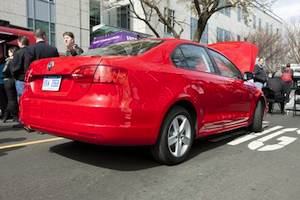
First Honda, then Hyundai, now Ford, is in the crosshairs of criticism over inflated fuel economy numbers. It’s not that an average driver can’t get the mpg numbers found on the window sticker when you buy the car, but can you get them – or even close – in normal driving? Hypermilers can routinely max out fuel economy. For reference I’d offer the doubling of the EPA estimates that Taylors managing in a stock VW Passat TDI this year. But that’s different from being subject to commuting traffic or just the random stop-light ambush. The Hyundai and Ford complaints followed legal action early this year against Honda for failing to deliver the promised fuel economy in its hybrids.
So is it just driver error that keeps ordinary citizens from achieving the promised fuel economy? There is some truth to that, but it’s not the big problem. Here is a run-down of the issues and what can be done to sort this out.
EPA Testing Distorts Real World Driving
Ford’s immediate response to complaints about the C-Max hybrid fuel economy shortfall was to blame the EPA test cycle. Hyundai’s response was more blunt – they admitted their data submitted to EPA (fuel economy numbers are self-reported by the car companies) was off and moved to offer cash rebates to car purchasers. Honda battled in court, with some success, against its detractors.
Ford’s point about the EPA test cycle is significant, particularly for plug-in hybrids that have a variable EV-only cycle. Ford claimed the fact that the C-Max could run in EV-only mode up to 62 mph allowed the car to turn in superlative numbers in an EPA test cycle that tops out at 60 mph. Of course, in the real world, 60 mph would be a dangerously slow speed on most freeways; above 62 mph the C-Max’s gasoline engine kicks in, supplying additional power while recharging the battery, but of course bringing down the overall fuel economy.
This points out a bigger issue with the EPA test cycle. It’s only real value is that it subjects every car to the same test. The test itself is a joke. Top speed: 60 mph. No air-conditioning use until they changed the test procedure in 2008. Numbers weighted 55% city driving/45% highway, just the opposite of the numbers the Department of Transportation says the average American drives. No wonder the numbers are off and have been tweaked to try to get closer to reality several times over the years, the most recent in 2008 when they added a more aggressive driving cycle and it resulted in lower mpg numbers for many cars.
The biggest challenge to the EPA comes from plug-ins with varying EV-only cycles and their relation to real-world driving. Here’s some examples:

They Chevy Volt can run about 40 miles on electricity. If your commute is less than 40 miles and you charge each day you won’t use any gasoline until the engine decides it needs to cycle on to keep itself in working order. What does that work out to in miles per gallon? Anecdotes from Volt owners claim the use of only tens of gallons of gas for thousands of miles of driving.
Diesel cars typically get significantly (30-40%) higher highway fuel than comparable gas models, but don’t have a lower efficiency increase in around-town driving. As a consequence, virtually every press report (and many owner ones) testify that the EPA numbers for diesels are under-reporting the real world fuel economy of those cars.

The Way We Really Drive
So it seems like the question is less about the car or the test, but how we plan to drive a given car. The challenge for modern car buyers is to match the vehicle and powertrain to their driving needs and patterns. As mentioned, if you’ve got a short, well-defined commute, a hybrid, plug-in hybrid or even an electric might work to minimize fuel consumption.
On the other hand, if you take regular longer trips or have an extensive commute, a diesel or high-mileage gasoline car might be the best choice. Then, of course, you also have to factor in other dimensions such as passenger and cargo space, which may further complicate the choice since not all models have multiple powertrain options.
The good news – as we saw at the recent LA Auto Show, the options are growing and it should continue to get easier to match up a specific driver’s needs and driving patterns with the optimal vehicle configuration and powertrain.
